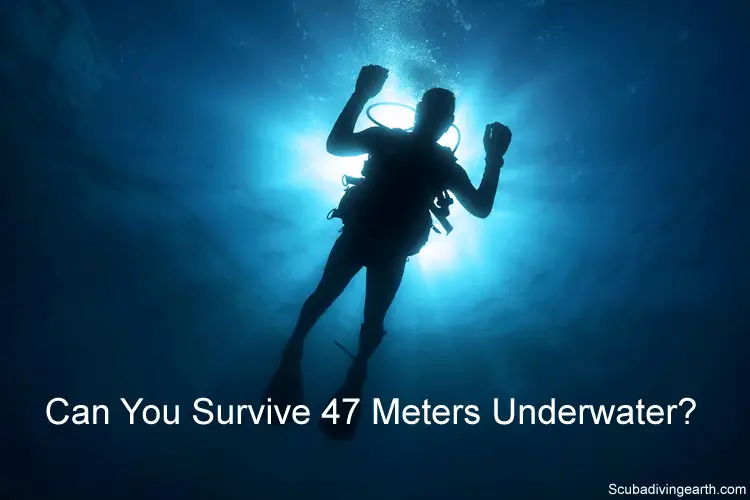
47 metres (154 feet) is considered a deep dive and only to be dived by experienced scuba divers
47 Metres Down is a fantasy movie about two sisters who end up 47 metres down with great white sharks. As a result of this scuba diving movie, people ask: “Can you survive 47 meters underwater“
If you are researching the answer to this question because you would like to scuba dive, it’s important to understand about surviving 47 metres underwater. You can you survive 47 metres underwater but to do so you need to have the necessary training and experience as a scuba diver. To survive a deep dive to 47 metres down you must follow decompression stop limits or carry out decompression stops on your ascent to avoid getting decompression sickness.
The best way to do more diving is to book yourself on a scuba diving liveaboard. You can check the latest and best deals on liveaboards using the following window:
As an aside, in this article about where to find great white sharks, you may be as surprised as I was to discover some of the places where you find great white sharks! Place number 6 is the one that surprised me the most, but if you live in the States, you may be more surprised at places two, three and four.
How deep is 47 metres in feet?
- A depth of 47 metres in feet is 154 feet.
- A dive of 47 metres in yards is 51.4 yards.
- Diving to 47 metres in miles is 0.0292044 miles.
- A depth of 47 metres in kilometres is 0.047 kilometres.
Please don’t leave before you watch the video in this article! Before you leave after you’ve got your answer about 47 metres down, you may like to watch the video on this article too. I almost don’t want to spoil the end of the video, so all I will say is it involves a carcass, many sharks and a single grouper…you may be surprised at what happens, I certainly was!
7 metres or 154 feet deep is the equivalent of the following:
- The length of 2.6 of the longest recorded whale sharks (record whale shark is 18 metres or 33 feet).
- 7.7 of the longest recorded great white sharks stacked head to tail (Longest recorded is 6 metres or 20 feet).
- 7.7 giraffes piled on top of each other (tallest giraffe is 6.1 metres (20 feet tall).
- 10 metres (30 feet) taller than the Leaning Tower of Pisa, which is 57 metres (187 feet).
- 5 metres deeper than Tower Bridge, London is tall, which is 42 metres (138 feet) high.
- The same height as the Eschenheimer Tower in Frankfurt, Germany which is exactly 47 metres (154 feet) tall.

How far is 47 metres underwater?
47 metres underwater is 154 feet or 51.4 yards and the equivalent of 0.0292044 miles. It would take you 42 seconds to walk this far walking at 2.5 miles per hour.
But how far is 47 metres underwater when compared to everyday items?
- 3.13 times the average length of a UK garden which is 15 metres (49 feet).
- 1.5 times the average length of a US garden, which is 104 feet (32 metres) and equates to 10,871 square feet
- Just under the length of an Olympic swimming pool, which is 50 metres (164 feet).
- Similar to the width of an American football pitch which is 53 1/3 yards wide (48.8 metres; 160 feet).
- Just under half the length of a football field, which are 100 metres (328 feet) long.
How long can you dive for at 47 metres?
You can dive for 8 minutes as a no decompression stop dive to 47 metres down using BSAC tables. PADI dive tables have a maximum depth of 140 feet (42.6 metres) which gives a no-stop dive time of 8 minutes.
Is 47 meters down a true story?
47 Metres Down is not based on a true story and the same is true of its sequel 47 Metres Down: Uncaged. If you watch 47 Metres Down as a scuba diver you will know how ridiculous the movie is, but even the writer Johannes Roberts refers to some movies as preposterous.
Roberts puts it like this: “For me what works about both movies is that they’re actually, as preposterous as they are, you know, they’re movies“.
He goes on to say in an interview with Roberts, “There was a wonderful three-page thesis someone wrote on the first movie about the inaccuracies of the diving stuff. And yeah, sure! But you know, if you went down 47 meters in a cage to the bottom of the ocean, with a tank, and you were an inexperienced diver, you would probably last about three minutes before you died or ran out of air.”
Have you heard about the ‘Scuba Diving Lizard‘? Take a read of this article about a lizard that can breathe underwater from a scuba-tank like bubble…I was fascinated when I read this!
More about the film 47 Metres Down?
The film 47 Metres Down has came in for major criticism from scuba divers for the mistakes in the dive scene. The criticism is around how realistic the underwater scene is. How true is the story or not?
The underwater scene when Mandy Moore (Lisa) and Claire Holt (Kate) sink to 47 metres down is certainly not realistic. The underwater sequence lasts for nearly an hour.
A dive time at 47 metres would probably require much more air than the dive tank they went down with. Even with the second tank that was sent down this would still not be enough air to last for 60 minutes at 47 metres. See below why scuba diving at depth requires more air. But in the explanation below this assumes a ‘gentle‘ relaxed dive, without much strenuous exercise.
In the film 47 Metres Down, Lisa and Kate are far from relaxed and they are also put through their paces too. This meant they would be ‘drinking‘ their air supply very very quickly.
More Reading: Is it dangerous to scuba dive?
You also see below how 28 minutes at 47 metres requires a total of 21 minutes of decompression stop time. But in the film the bottom time is nearly double this time. The decompression stop time would more than double the stop time of a 28 minute dive.
In the movie 47 Metres Down Lisa is told to do a deco stop for 5 minutes at 20 metres (67 feet). With such a short decompression stop for such a long dive at 47 metres she would definitely get decompression sickness.
With the length of dive and resulting amount of nitrogen build-up she would have suffered from severe decompression sickness (or the bends). If she wasn’t taken to a hyperbaric chamber she may have even died.
I’m sorry to spoil the movie for those of you who enjoyed it. As long as you apply real escapism to the movie, then who cares about the true facts of scuba diving to depth?
More Reading: How deep can you dive without decompression – with decompression stop limits
Trailer to the movie 47 metres down
How realistic is 47 meters down?
The movie 47 Meters Down is completely unrealistic. This includes how much air is consumed in 60 minutes at 47 metres; how fast Lisa ascends to the surface is unrealistic with only 5 minutes decompression stop time allowed.
Please read on to discover the alternative ending to the movie 47 Metres Down.
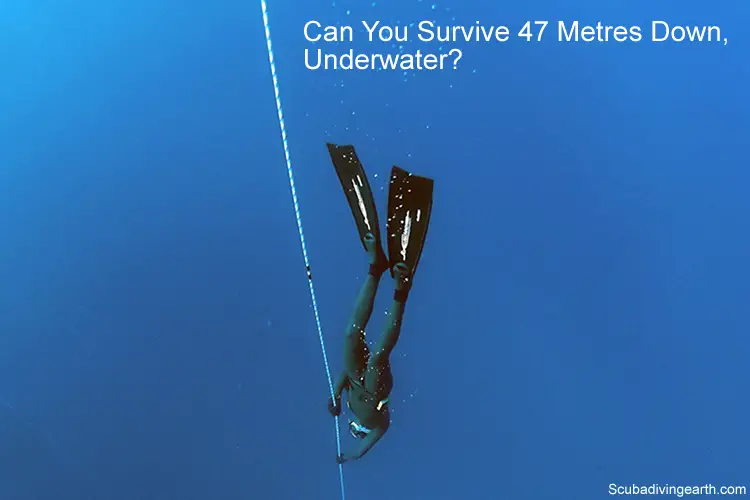
Can you survive 47 metres underwater?
Scuba divers can survive 47 metres underwater, but unless you restrict your dive time to 9 minutes your dive will turn into a no-stop decompression dive meaning you must stop to decompress on your ascent. 60 minutes at 47 metres would take several hours to surface safely with long decompression stops.
Diving to 47 metres is 7 metres beyond the PADI recreational diver limit of 40 metres.
Scuba diving to 47 metres (154 feet, 51.4 yards) is considered a deep dive.
Read More: Deep diving explained plus 26 tips for deep scuba diving
I’ve dived to 47 metres (154 feet, 51.4 yards) on many occasions and deeper. This means a dive to 47 metres carries more risks. See below for the risks associated with scuba diving to 47 metres and deeper.
All scuba diving carry an element of risk, but the risks and the dangers of diving can be minimised. Any dive deeper than 30 metres (100 feet) is a dive only to be considered by an experienced and well trained scuba diver.
PADI limit normal recreational scuba diving to 30 metres (100 feet). But PADI increase this depth limit to 40 metres (130 feet) if you take their ‘Deep Diver‘ course.
This means a scuba dive to 47 metres (154 feet) with PADI is not an option.
Please don’t leave before you watch the video in this article! So before you, you may like to watch the video on this article too. I almost don’t want to spoil the end of the video, so all I will say is it involves a carcass, many sharks and a single grouper…you may be surprised at what happens, I certainly was!
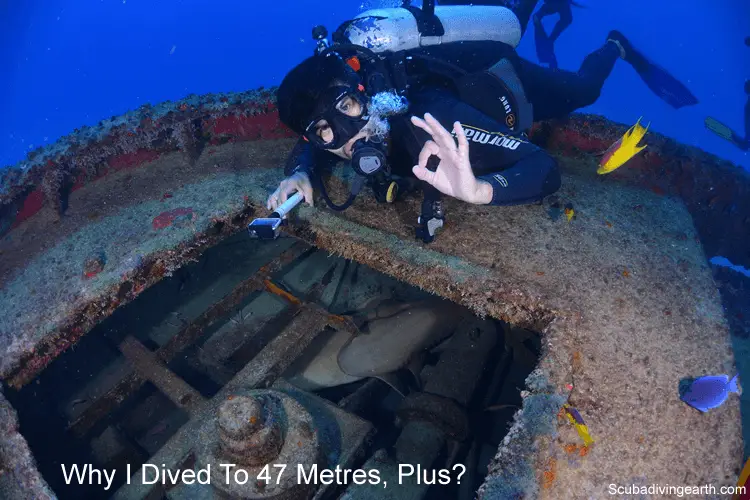
Why I dived to 47 metres, plus?
So you may now be asking ‘how is it that you’ve dived to 47 metres plus?
I certified as a scuba diver with BSAC and not PADI. My BSAC Dive Leader certification permits me to dive safely to 50 metres (164 feet).
In my scuba diving career I’ve dived many 40+ metre (130+ feet) dives. But with this type of diving comes with more risk.
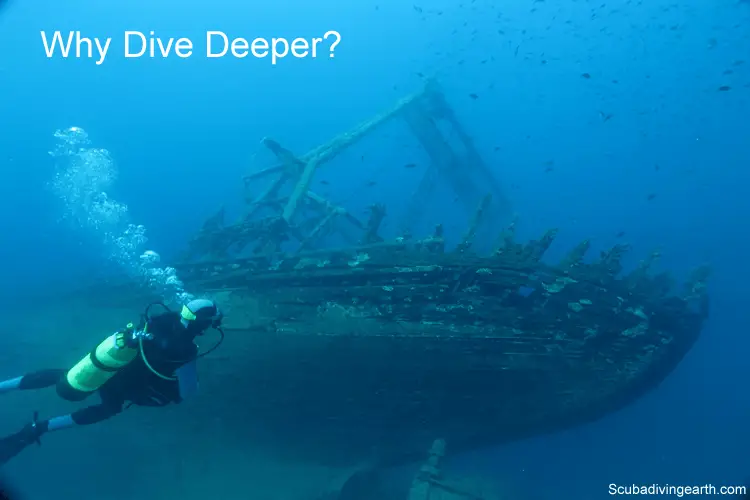
Why dive deeper and why dive to 47 metres?
Any dive should have a purpose. The same goes for diving deeper as there should be a purpose for the dive. Diving deep merely for the ‘bragging rights,’ is a fools game.
So what might there be at 47 metres down? In the UK there are a huge number of wrecks to dive. These wrecks are as a result of two world wars and the UK are a shipping country.
With that there are a huge number of ships that either sank due to bad weather or were sunk in battle during one of the world wars.
More Reading: Truk Lagoon deep wrecks sunk during World War II
The problem is, when a ship sinks, the wreck sinks where it is in the ocean. That might be at 10 metres (30 feet), or it may be at 47 metres (154 feet). If the wreck concerned is of interest and it happens to be at 47 metres, then it gets dived at that depth in the UK.
This same concept applies in other parts of the world too. There are many great ship wrecks at depths that scuba divers visit. Some of which are beyond PADI’s recreational limit of 30 or 40 metres.
If you are already a scuba diver and would like to dive deeper, you may need to change diving organisation. This is especially true if you learnt to scuba dive with PADI.
If you need reassurance about scuba diving, let’s take a look at the risks that are specifically associated with deeper diving. But also I will include ways to mitigate those risks.
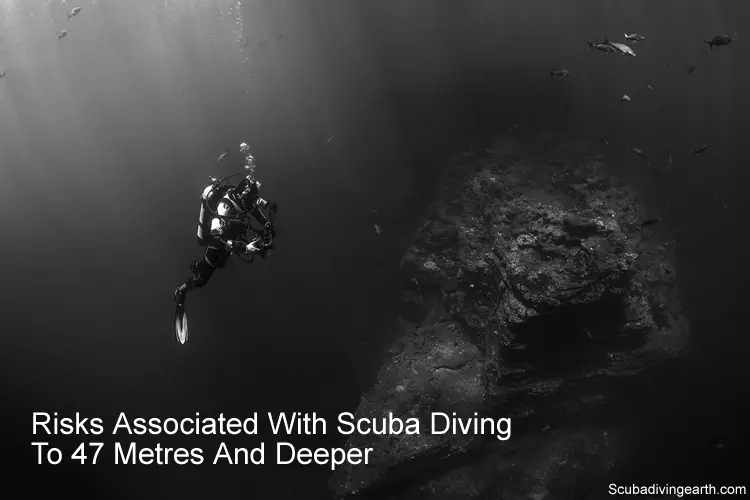
Risks associated with scuba diving to 47 metres and deeper
Deep diving is relatively safe as long as you follow all the rules and procedures. But I thought it best to cover the risks associated with diving to 47 metres.
Risk #1 of diving to 47 metres underwater – risk of running out of air
The first risk associated with diving to 47 metres is running out of air.
The deeper you dive the greater the water pressure. With this increased pressure air gets compressed. So the deeper you go the more your air will get compressed, which is Boyle’s Law.
Your lungs are air sacks which require more air to fill them at depth than at sea level. For example, your lungs require twice the volume of air to fill them at 10 metres than at sea level.
As a result you breathe more air the deeper you dive. So you will go through your 200 bar (2,900 PSI) air tank much quicker at 47 metres (154 feet) than you would at 10 metres (30 feet) or less.
In essence: The deeper you dive, the less time you have to dive with the same amount of air in your dive tank.
The risk therefore at 47 metres is of running our of your air.
How to minimise the risk of running out of air
To minimise this risk of running out of air at 47 metres make sure you check your air contents gauge more regularly. But having said that I suggest this is not too different to diving at any depth. But as your air will be consumed faster at depth, you are advised to keep a more focused check on it.
You should read this article about the top 10 pro safety tips for scuba diving. But check the section on how often to check your air contents gauge.
You must also make sure you have enough air to get you back to the surface. Which will require more air from a depth of 47 metres than it would be from 30 metres.
But you also need to take account of decompression stops too where relevant. See below.
More Reading: 28 tips to conserve air when scuba diving
Risk #2 of diving to 47 metres underwater – risk of nitrogen narcosis
The second risk of diving to 47 metres or similar depth is nitrogen narcosis. The risk of nitrogen narcosis increases the further you dive below 30 metres (100 feet).
At sea level and on land you are subject to what’s known as ‘one atmosphere’ of pressure. This is known as atmospheric pressure (one bar). This pressure amounts to a weight of 10,000 kg m–2, or 14.7 pounds per square inch.
More Reading: What are the advantages of diving with Nitrox
Sea water is 800 times more dense than air
Sea water is approximately 800 times more dense than air at sea level. This means that underwater pressure increases by one atmosphere for every 10 metres of descent below the surface. For example, at 10 metres (100 feet), the pressure is now two bar or two atmospheres.
If you dive to 47 metres down (154 feet), which is roughly 50 metres (164 feet), the pressure would be six bar or six atmospheres. This is six times the pressure of the pressure on land.
This results in a higher concentration of nitrogen at depth than it is at the surface. Which at 47 metres this is roughly six times the concentration.
Nitrogen represents about 78% of air. Nitrogen breathed at atmospheric pressure has no effect on us as it’s an inert gas.
However, as you go deeper this changes and nitrogen becomes intoxicating. The effects are similar to nitrous oxide inhalation.
This progresses from euphoria to drunkenness to confusion and sometimes to unconsciousness. However in some scuba divers dysphoria (a state of unease) and paranoia occurs. This can lead to panic with some scuba divers.
I have suffered from a bad dose of nitrogen narcosis, which funnily enough was at around 47-48 metres. To find out more, please read this article about how to overcome panic when scuba diving.
The risk of diving to 47 metres is therefore suffering from nitrogen narcosis or the narks.
How to minimise the risk of nitrogen narcosis
The first and simplest way to avoid nitrogen narcosis is to limit your scuba diving to no more than 30 metres (100 feet).
This is actually what I have done. I rarely dive deeper than about 25 metres these days. I no longer dive on deep wrecks to 50 metres or so. That’s not to say that you can’t or shouldn’t dive deeper.
The second way to minimise this risk is to build up your dives. Don’t dive straight to 47 metres or whatever depth it is you are planning to dive below 30 metres.
By slowly building up the depth of your dives during a season, you build up a bit of a resistance to the effects of nitrogen on your body. However, this isn’t a guarantee, as was shown by what happened to me.
Consider using nitrox, which has a higher percentage of oxygen in your air. But with a 32% mix of oxygen you are limited to a depth of 37 metres (121 feet). You will need to take more training for diving using nitrox.
Alternatively, you use mixed gases. Using mixed gases at depth changes the composition of the air you are breathing. This is technical diving, which is a type of diving that I’ve not done myself. So I won’t explain this anymore in this article.
However, having said that the technical divers will probably say; using trimix gas at 47 metres would be wasted as it’s expensive.
Risk #3 of diving to 47 metres underwater – Decompression sickness
The next risk that’s associated with diving deeper is the risk of decompression sickness or DCS.
Decompression sickness is caused by a scuba diver coming up too fast from a dive. The cause of decompression sickness is as a result of the dissolved nitrogen being released too quickly from your body’s tissues on ascent.
This released nitrogen forms bubbles. It’s these bubbles that can cause major problems. These problems can be as minimal as a skin rash or a skin bend, to the extreme of a fatality.
The deeper you go the faster and the more nitrogen dissolves into your body. Once the amount of nitrogen dissolved in your tissues goes past a certain limit the dive becomes a decompression stop dive. Which means you must stop on your ascent to increase your decompression time.
However, if you want to limit your dive to a no decompression stop dive, you need to limit your bottom time accordingly. For example, at a depth of 47 metres diving on the BSAC Table A you have a total of 9 minutes no decompression stop time at this depth.
If you exceed your no-stop bottom time you have to do decompression stops on your ascent
If you exceed the no-stop dive time, you fall into what’s known as a decompression stop dive. This means that in addition to using your ascent from your dive as decompression time, you will also need to incorporate certain decompression stops too.
For example, if your dive time at 47 metres went to 28 minutes, this would involve two decompression stops. One at 9 metres (30 feet) for three minutes and a second decompression stop at 6 metres (20 feet) for 18 minutes.
The important thing to note is that you not only need enough air to complete your bottom time of 28 minutes, bearing in mind your increased air consumption due to the depth of the dive, plus you’ll need enough air to get to both decompression stops and to carry out the stops.
On top of that you then need to arrive at the surface with your reserve air, which is generally accepted as 50 bar (725 psi).
The risk is therefore decompression sickness due to not decompressing properly on your return to the surface. The risk of which is increased due to how quickly decompression time sets in at these deeper depths.
For example, I remember getting towards the time to ascend from a 50 metres dive (164 feet), and at the time we had over 20 minutes of deco time. But for some reason I couldn’t release my delayed surface marker buoy.
More Reading: What is a surface marker buoy used for? (Safety diving equipment)
The delay was only a minute or so but this added a significant amount of time to our decompression stops. At depth things can go wrong quickly. So be prepared and don’t dive tired and be cautious.
How to minimise the risk of decompression sickness
The easy way to avoid decompression sickness is to follow the correct ascent rules of scuba diving. You must not ascend too quickly for a start. But you must also carry out decompression stops when necessary. Furthermore use a dive computer to calculate bottom times, ascent rates and decompression stop times.
To reduce the risk further, you are better to only dive no stop decompression dives. However, this will limit the amount of time you have on the bottom.
There’s not much you can do or see on a wreck in 9 minutes. This is especially true if it’s a particularly large wreck.
More Reading: Is scuba diving more dangerous than skydiving?
47 Meters Down movie alternative ending
The film 47 Metres Down, might have had an alternate ending. But the alternate ending might not be Hollywood at its best or at their most exciting.
The alternative ending might be that sisters Kate and Lisa:
- Carefully plan their ascent from 47 metres down
- They would carefully checking their total bottom time.
- Their dive planning would include a dive computer.
- With a correctly calculated bottom time and carefully planned deco-stops, they would ascend slowly to the surface.
- On their way to the surface they would stop at the various decompression stops, for the right amount of time.
This alternative ending to 47 Metres Down may please the scientists and the die-hard scuba divers who understand decompression and decompression stops. But for those who just want to enjoy a thriller or a horror movie, it probably doesn’t really matter.
For pure escapism it’s sometimes okay to stretch the bounds of science.
The final step in the ‘less-exciting‘ 47 metres down alternate ending would be for Kate and Lisa to carry out a safety stop for three minutes at 5-6 metres (16-20 feet).
Safety stops are precautionary stops scuba divers do for safety. But for Hollywood actors and a in film where the characters are escaping from sharks, safety stops are not likely!
I hope this article doesn’t spoil your fun of watching the movie. But if you’re genuinely researching the concept of scuba diving to 47 metres for the purpose of being safe when diving, then I hope this article has helped.
More reading: Is it dangerous to scuba dive with sharks?
Don’t forget to take a look at this article about where to find great white sharks, you may be as surprised as I was to discover some of the places where you find great white sharks! Place number 6 is the one that surprised me the most, but if you live in the States, you may be more surprised at places two, three and four.
I hope you enjoyed this article about can you survive 47 meters underwater
I’d love to hear from you. Tell us about your adventures of diving and snorkeling, in the comments below. Please also share your photos. Either from your underwater cameras or videos from your waterproof Gopro’s!
If this article hasn’t answered all of your questions. If you have more questions either about snorkeling or types of scuba diving (or specifically about can you survive 47 meters underwater), please comment below with your questions.
There will also be many more articles about scuba diving (and snorkeling) for you to read and learn about these fabulous sports.
Have fun and be safe!

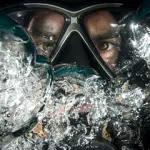
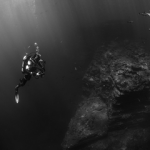
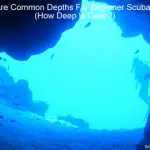

Usually I don’t bother about comments as they are time consuming, but I had to say something about your splendid write up. I couldn’t have said it any better myself. You did not miss out anything. Congratulations. I am a one star BSAC Diving Instructor for these last 33 years with over 2000 dives. I come from the island of Malta and this part of the world is a haven for scuba diving all year round, bar some heavy incliment weather. Wrecks are a plenty and I had the personal satisfaction back in 1993 to find a WW II German JU-87, commonly known as the ‘Stuka’ wreck. On impact this aircraft had its engine torn off from the rest of the plane and it was there for the picking. I marked its location, and on land I notified the authorities that I am going to lift it up and donate it to the War Museum, which I did with the help of a tugboat with a lifting crane from surface to deck. We used a 5 ton airbag from bottom to surface, 30 mts give or take. I used to work as a senior operations officer with this tug company and borrowed a tug and it was a cinch to lift was must have been at a rough guess 800 kgs. of engine. It is on display today and I have visited it many a time with tourist friends of mine. Tonight, thinking of watching a movie I came across this’ 47 metres’ crap and on searching wiki about it to see if it is crappier than the first it looks like it. Movie or not, it gives scuba diving a bad name and people very wrong impressions. Your article made my day though and if you like I will send you photos of the restoration of the Stuka engine which I did myself. Oh, by the by, back in 1987 (this from my log book) I dived to 50 mts. with a bottom time of 43 mins. I had to decompress for a total of 48 mins and for extra safety I added 10 more. Had 2 tanks… an 18 lt @220 bar and a 12 lt @200. Since then I have never ever again dived that deep with such a bottom time. It was reckless, stupid and decompressing that long nearly sent me round the bend (no pun intended) just floating and trying to keep depth steady. Take care and should you ever come here to Malta look me up.
Hello Lesley, thank you so much for taking the time to write your comment, especially after you say you don’t usually bother!! Very gratefully received. What an amazing story and yes I’d love to see the images and a bit of a write up of the story, if you’re happy to spend a few moments doing this. I love to receive scuba diving stories, and this one would certainly interest me. If you are happy to add some words to the images, and if you’re happy for me to incorporate these into a ‘Scuba Story’ on my blog, please send then to support [@] scubadivingearth.com…The funny thing, I was only talking about Malta today with my two nieces who recently were certified to scuba and would love to come at some point and will for certain look you up!!
Hiya Russel, thank you for describing the recovery of the engine as amazing. To tell you the truth I never thought of it as amazing as the time, but the truth of the matter is yes it is amazing as everything had to happen at the right time especially having the access to a tugboat then and the place where the plane crashed was one of my favorite diving spots that I knew it by heart. I intend to send you a write up and the images are already worded, so I will send everything at the e-mail address you gave me. Now then see if I got it right: support [@] scubadivingearth.com. Do I mark it for your attention or do you open the mail yourself? In any case I will begin by saying, For the attention of Russel. I hope you will like the story. You know what is a pity… the second time I dived on the plane after the diccovery I videoed the whole scene for the record but unfortunately I never bothered to transfer the video tape to cd… got many tapes to do in reality, but if I had done so, it would have enchanced the story even more. Mentioning the video tape, I remember I made an emphasis on camera, showing part of the undercarriage with a tyre still inflated…I mean geez after 50 or so years underwater. The bits of the plane large and small are still there for though there was no sign of a body ( the pilot) I felt it as very unbecoming to desecrate what could be a war grave. The engine like I said was torn clean off and quite a bit from the plane and that made me comfortable enough to recover it. Maybe if you do come by to here we might just go and have a peek to see if everything is still there. Heq 26 years have passed since then, but the dive itself should be fun. Till the next Russ. Leslie.
Hiya Leslie, thank you for getting back to me and yes the email you entered in your reply is exactly right (BTW, I’ve edited it with the brackets to help avoid loads of spam, as I think online bots pick email addresses up if written exactly as they should be. I hope that makes sense.) And yes it will be me that reads the email. You telling the story of the tug boat makes me smile, because a couple of us raised a gun a few years back and we were towing it behind the boat and things got tangled. It was me who agreed to go under the boat to untangle everything and I remember being bash on the head by the boat with the swell and feeling a bit sea sick with the moving up and down in a strange position!! Shame about the video, that would have been brill! Anyway, I really look forward to your story, images etc. I will write this up and send it to your email for prior approval by you and then post – if that works for you. Take care and have a lovely day, Russell
Hi Russel, Ernest Hemingway here hahaha… Took me more than 3 hours to write up the story, upload the photos and send. Feel like Ernest Hemingway lol. Well after reading slowly what I sent I have absentendly forgot to give my dive depth and bottom times of the 2 dives to recover the engine but found them to be of little consequence to anyone who is a diver as I had already given the depth. In any case if you feel that I may have missed something or clarify just let me know for I wrote all that at one rush, with just refering to my logbook and this story is 26 years old in reality, and wrote all from memory My I am getting old.but there’s still pep in this old salt yet. In any case, like I said if I get the time to transfer my video tape on to a cd I will let you know and send it. But if you ever come to Malta I will show you the real thing. What you have said works for me fine and some editing might be needed too so you go ahead. Have a lovely day yourself and just occured to me. The movie ” 47 metres etc” may be crap but I feel it was just it that made us connect to what I hope to be correspondence in the future. T ake care Russel. Leslie.
Hiya Ernest AKA Leslie, I look forward to reading it and I will get back to you. I just want to say thank you once more for taking your time out to do this. Plus like you say, if it wasn’t for this film and my article we wouldn’t be talking.
Plus did you know, there’s a sequel out of 47 Metres down…the new movie is called ’47 Meters Down: Uncaged’ which was released only on 16th August 2019. This new 47 metres down movie is about 4 teenage divers who discover sunken ruins of a Mayan City. From what I understand the plot is based in Cenotes in Mexico where they come across sharks once more. The reviews are not too good so far and on IMDB it’s rated 5.4 out of 10 from 512 votes…so you never know, you may find yourself drawn to watching this film too?
Take care and speak soon, plus I’ll be in touch soon by email with the updated story! Russell 🙂
P.s. If you manage to sort the video out at a later stage, I can always add this later!, 🙂
Hi again Russ. Actually if you read back to my first response it was about the second 47 mts Uncaged that I was talking about and from the wiki I read about it if looks crappier than the first. A cave dive In Mexico with white sharks and pray tell me what are great whites doing in a dark cave where little or none at all food is found not the mention the claustrophobia they would feel just like we do in a very closed enviroment. The great white is an epipelagic fish and the word comes from the Greek word ‘pelagos’ meaning open sea. So this is the first crap. Never mind the sharks for the time being… a cave dive with no rope attached at the entrance and no open water to decompress from 47 metres. This is just enough to throw whatever I have at hand at the screen if I were to see it.
On another note I was researching a bit and found that a device attached to a VCR and PC can transfer vids to discs but when it comes to PC’S I am the most stupid guy of all. I can use it but don’t understand the works of it, but will sort it out eventually and will surely send it. Meantime I hope I made out the story good and again feel free to edit…maybe you can add that a white shark tried to gnaw the engine and the depth was 47 mts and we had to fight it off hahaha. We call the story 47 mts down. Search in Terror. Talk later buddy. Leslie
Hi Leslie Hemingway, my apologies for mixing up which ’47 Metres’ film you’d seen. Yes I agree about the great white sharks, these of all sharks have voracious appetites to maintain their body temperatures…I like the idea of the artistic licence on your story about sharks though!! Although I could be wrong, but when was the last time you saw a shark in the Mediterranean, let alone a great white shark!?|!?? Don’t worry, I know you’re only joking. Take care mate and thank you once again, I’ll be in touch soon, Russell
Hi again Russ. Let me quote to you a piece of news that I reserarched,for in 1987 nobody could beleive the news.
This is the story of one white shark captured in Malta April 17, 1987. Alfredo Cutajar, a local fisherman, of the fishing village called ‘Wied-iz-zurrieq’ was out for his daily tour. It was the time of the year for fishing tuna and swordfish, so he had a hook 25 cm long tied to a big rope and a ballast of stone. It is a type of fish that is very popular for Maltese fishermen because of always excellent profits. But this time not a single tuna or swordfish was biting Alfredo’s steel hook (Alfredo is nicknamed “Son of God” by everyone because he is the only one who catches all the biggest sharks that visit our waters).
At exactly 4:30 a.m. on April 17th, Alfredo boarded his 5 meter boat, powered by a 9.9 CV outboard, prepared for his lonely tour of checking his hooks and collecting his bait. After about 1/2 hour he arrived at the point where he left, as a rule, his first hook. His lines were always connected to a big marker, either a big cork or an empty jug. Checking them one by one, he saw that one of the cork floats was submerged and that something big was attached: a swordfish or maybe a tuna.
He approached the float and tried to anchor the rope of the line but it was too heavy and stuck. He looked around hoping to see someone in the vicinity who could help him. He saw a big fishing boat and began signaling so that it would come to help him. Quickly the big fishing boat reached him and soon the line was fastened to the windlass and hoisted on board. While this was going on, Alfredo noticed an enormous white shape coming out from the deep blue sea. Nearer the surface, Alfredo realized that he was dealing with a gigantic shark that was struggling for life. Little by little it was brought to the surface: it was almost two times the length of Alfredo’s boat. It was so enormous that it was necessary to hang it alongside the big fishing boat and it took three hours to return to the village. When they arrived, the shark was still showing signs of life while the people gathered around to look at it. But disappointingly, the shark was too heavy for the available dock davit, which was used only for hauling small boats, so the big fishing boat and shark went back to sea to another fishing village, Marsaxlokk, where there is a crane on the dock. There also a big crowd gathered. I was present, with a tape measure, in order to take down all the shark data.
The monster was barely out of the water up to its stomach when I and another fisherman began to cut it open. We pulled out a completely intact 2 m blue shark, a dolphin of about 2.5 m in two pieces and a 70 cm turtle. Only the head of the dolphin was in a state of putrefaction. The liver of the shark measured from one end to the other about 4 m. When it was carried to land and completely examined, we realized we were dealing with a female. The uterus open, I discovered that only a week before she had given birth to 10 pups, after 22 months of pregnancy. Therefore being very hungry, she swallowed all that happened to come in front of her. That is normal for a white shark. Moreover, normally the male remains around the female until the end of the gestation and the birth of the pups. That must have been what happened too to Alfredo’s shark because a male was seen in the area during those days and a fisherman who had caught a glimpse of it described it as about 6 meters long. And also this confirms the hypothesis that the male is always smaller than the female. Other proof that a white male shark was around was the statement of a local fisherman who told of having found a broken steel line without its 25 cm hook.
To be sure I measured our shark two times from the point of the snout to the point of the upper lobe of the tail. It was 7 meters and 14 centimeters long. Considering the curve of the abdomen, I was able to arrive at 8.85 meters, but that wouldn’t be correct because the shark is to be measured in a straight line. And it is the new record; the previous one was that of a 6 meters and 40 centimeters shark captured at Castillo de Cojimar (a few kilometers from Havana, Cuba) in March of 1945, also a female of about 3 tons. It is the biggest and officially verified by the Guinness book of records, because all the other examples captured couldn’t ever be proved. But now, the 7 meters 14 centimeters shark captured in Maltese waters has surpassed the record. The length has been confirmed by three scientific marine institutes. The weight has been estimated at 3 tons including stomach contents and liver. The age is estimated at 25/30. I concluded the age after having estimated the rings of one of the central vertebrae below the dorsal fin (Note that the original said “central vertebrae of the dorsal spine”). The jaw belongs to me and is exhibited in the government museum of history and culture on the island of Gozo. Luckily the shark did not break any teeth trying to free itself from the steel hook. It is the most complete and biggest white shark jaw in the world. By John Abela
How’s that for a story. I happen to know John and I saw a photo of the jaws with John posing. Now then shark sightings are common near the island of Filfla, a small unhibited island which is part of the Maltese archipelago of islands. It is off limits to everyone within a mile radius for rare lizards live there which are unique in the world. Seems we do have a “Lost World” after all. Till later Russ. Leslie.
Hello Mr Hemingway, what a great story about a great white shark – thank you for sharing this. I’d love to see the picture of the jaw of this shark and this is another whole story in itself!! Cheers, Leslie, Russell
Nice article. Just one correction. You say “That means a scuba dive to 47 metres (154 feet) with PADI is not an option. ” This is true of PADI Recreational diving, but PADI does Tec training also. I think the deepest currently possible under their training is 100 meters.
Hello David, thank you for your comment and kind words and yes you are correct. Sorry I meant their recreational dive depth, which applies to the majority of PADI divers, which is 40 metres (132 feet).
Then max depth for tech diving with PADI does depend on the tech course you do. But if for example you did the Tec-50 this would enable a dive to 47 metres underwater or to a max of 50 metres (165 feet). See here on the PADI website: https://www.padi.com/courses/tec-50